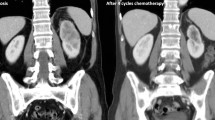Summary
Bellini duct carcinoma accounts for 1–3% of all renal carcinomas and is characterized by an aggressive course and extremely poor prognosis. Conventional treatment for renal-cell carcinoma seems to be ineffective. Since the histology of Bellini duct carcinoma is similar to urothelial carcinoma, chemotherapy for urothelial cancer might be more promising than conventional treatment. We present a patient with renal carcinoma of the left kidney who underwent laparoscopic extrafascial nephrectomy and adrenalectomy. Histopathologic work-up showed Bellini duct carcinoma (pT3a, NX, G3, R0 and M0). Eight months after surgery, disease progression was observed with local recurrence, multiple pulmonal lesions, para-aortic and aortocaval lymphadenopathies and a solitary bone lesion. First-line treatment with interferon-alpha and interleukin-2, as well as second-line treatment with thalidomide, were ineffective. Disease progressed rapidly and the patient experienced a dramatic reduction in performance status and quality of life. Six courses of chemotherapy with cisplatin and gemcitabine were given, a treatment reported to be highly active in urothelial cancer. The treatment was well tolerated, with thrombopenia WHO grade II, anemia WHO grade I and nausea/vomitus WHO grade II being the most severe side effects. Follow-up computer tomography revealed partial remission with 50–100% response at the different sites of metastasis. This response was accompanied by a dramatic improvement in performance status (from an initial 60% to 100% Karnofsky index) and quality of life. The combination of cisplatin and gemcitabine was highly active in this patient with metastatic Bellini duct carcinoma, even given as third-line treatment. This regimen fulfils all criteria for palliative treatment, as our patient showed an impressive improvement in WHO performance status and therefore in quality of life. Histopathologic characteristics should be a major criterion for treatment strategy in renal carcinoma, particularly in Bellini duct carcinoma.
Similar content being viewed by others
Author information
Authors and Affiliations
Rights and permissions
About this article
Cite this article
Fakhrai, N., Haitel, A., Balassy, C. et al. Major response and clinical benefit following third-line treatment for Bellini duct carcinoma. Wien Klin Wochenschr 117, 63–65 (2005). https://doi.org/10.1007/s00508-004-0289-4
Received:
Accepted:
Published:
Issue Date:
DOI: https://doi.org/10.1007/s00508-004-0289-4




